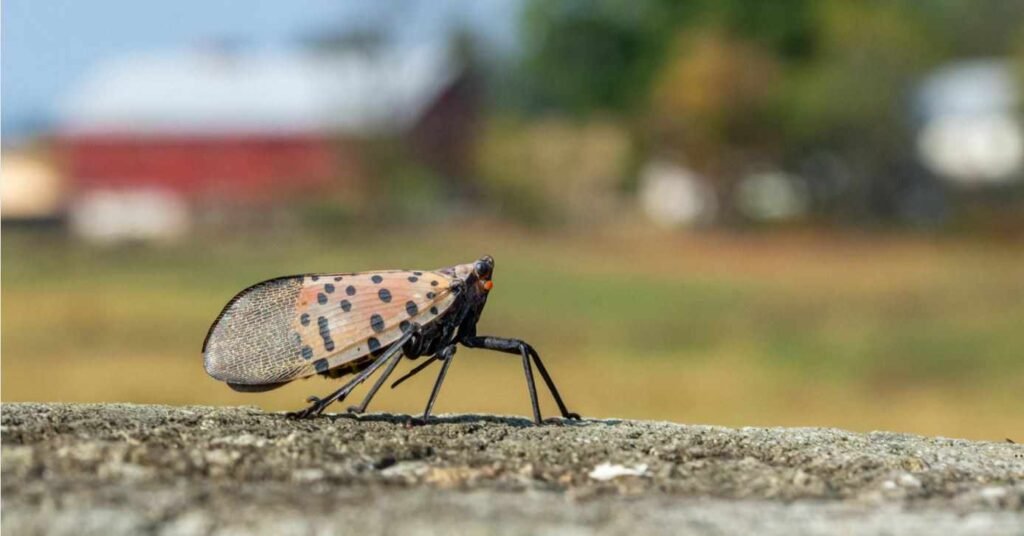New lanternfly species Vietnam Cambodia regions have recently been identified, showcasing the incredible biodiversity of Southeast Asia. These fascinating insects, known for their vibrant colors and unique wing patterns, play a significant role in their ecosystems. Researchers are studying these newly discovered species to better understand their behavioral traits, habitat needs, and potential impact on their environments.
Imagine strolling through the lush, humid forests of Southeast Asia, where every leaf and tree trunk could be hiding an incredible discovery. The dense greenery of Vietnam and Cambodia recently hosted nature’s latest reveal—a new lanternfly species Vietnam Cambodia that has left both scientists and nature enthusiasts astonished. Lanternflies, known as some of nature’s most exquisitely designed insects, belong to the family Fulgoridae and are renowned for their vibrant hues and fascinating patterns. This discovery not only deepens our understanding of biodiversity but also underscores the importance of preserving these fragile ecosystems.
This blog explores the new lanternfly species in Vietnam and Cambodia, its breakthrough discovery, unique traits, ecological significance, conservation concerns, and much more. Join us as we unravel this incredible story.
Must Read: Riley Affenhance Redirect: Boosts Your Web Success
The Discovery of a New Lanternfly Species Vietnam Cambodia
Where Was it Found?
The new lanternfly species was discovered deep within Southeast Asia’s untouched rainforests, specifically in regions of Vietnam and Cambodia. These habitats are known for their remarkable biodiversity and house some of the most beautiful and rare creatures on Earth. These two nations feature a mix of tropical and subtropical climates, creating ideal conditions for a wide range of fauna, including our mysterious lanternfly friend. Researchers reported the first sighting in [insert specific location, such as the Annamite Mountains for illustrative purposes], where biologists were conducting a field study focused on lesser-documented insect species.
The secluded environment, combined with dense vegetation and favorable weather conditions, provided the perfect breeding ground for this newly uncovered marvel. Early indications suggest that this lanternfly species thrives in specific tree hollows and feeds off sap, behaviors consistent with other members of the Fulgoridae family.
The Moment of Discovery
The scientific breakthrough came during a biodiversity expedition organized by a group of entomologists and ecologists aiming to document unclassified insects. The team’s keen eyes spotted this brilliant creature strutting through the forest canopy, its distinctive patterns and striking colors immediately sparking interest. After careful observation and extensive documentation, DNA samples confirmed it was indeed a new lanternfly species previously undocumented by science.
Who Made It Possible?
Behind the exciting discovery were globally renowned entomologists and local conservationists, supported by international wildlife organizations. This collaboration allowed for a meticulous identification process, aided by Vietnam and Cambodia’s emerging biodiversity research efforts. Even local citizens contributed by tipping researchers off about “strange insects” spotted during farming activities.
Behavior and Lifecycle of the Species
The newly discovered lanternfly species exhibits behaviors that are both intriguing and crucial for its survival. It is primarily nocturnal, becoming most active during the cooler hours of the evening to avoid predators and harsh daylight conditions. The insect feeds on sap from specific host plants, relying on its elongated proboscis to access this vital resource.
Its lifecycle consists of several stages, beginning with eggs laid on tree bark or leaves, followed by a series of nymphal instars before reaching adulthood. Each stage serves a significant role in the insect’s development, with nymphs often displaying camouflage patterns to blend into their surroundings for protection. This species also seems to exhibit a fascinating seasonal pattern, with increased reproductive activity preceding the onset of the rainy season, when ample resources ensure a higher survival rate for their young.
Unique Features of the New Lanternfly Species Vietnam Cambodia

What makes this newfound lanternfly species so extraordinary? Every detail about its appearance and behavior paints a picture of nature’s creativity.
Intricate Physical Features
This lanternfly species proudly exhibits stunning, iridescent wings that shimmer under sunlight. Its body is elegantly streamlined, resembling a living jewel. Patterns resembling intricate stained glass adorn its wings, with bursts of color that fade into harmonious gradients. Unique to this species are glowing, bioluminescent markings that appear during the night—distinguishing it from other known lanternflies.
These physical traits don’t merely captivate the observer—they serve biological purposes such as camouflage, mating displays, or warning predators.
Behavioral Characteristics
The new lanternfly species discovered in Vietnam and Cambodia exhibits fascinating behavioral traits that set it apart from its counterparts. Primarily active during twilight and night, it uses its bioluminescent markings not only for communication but also to deter potential predators. Unlike many other species, this lanternfly shows a unique preference for residing in dense forest canopies, often remaining hidden during daylight hours to avoid predation. Feeding habits primarily consist of sap from specific tree species native to the Vietnam and Cambodia regions, suggesting a co-evolutionary relationship with its habitat. This meticulous behavior ensures its survival while contributing to the ecological balance of its environment.
Ecosystem Impact of the New Lanternfly Species Vietnam Cambodia
Finding a new species is like adding a missing piece to the puzzle of an ecosystem. Lanternflies are not just passive inhabitants; they’re active contributors to their environments.
Supporting Local Flora and Fauna
Lanternflies, including this new species, often act as pollinators. While feeding on sap, they inadvertently transfer pollen to nearby plants, aiding reproduction. Additionally, their presence offers a food source for local predators, establishing their role in the food web. This strengthens the forest’s intricate ecosystem, contributing to the flourishing biodiversity of Vietnam and Cambodia.
Potential Concerns
While this discovery is a cause for celebration, researchers are watching closely for any unexpected disruptions the new species might cause. For example, could its feeding habits harm certain tree species? Additionally, as lanternflies are known to be invasive in non-native regions, strict monitoring will be vital.
Conservation Concerns Surrounding the New Lanternfly Species Vietnam Cambodia
Importance of Protecting Its Habitat
The discovery of the new lanternfly species Vietnam Cambodia highlights the importance of preserving the natural habitats where these unique insects thrive. Healthy ecosystems provide the necessary conditions for species like this to flourish, maintaining the balance of biodiversity in the region.
Protecting these habitats ensures that the new lanternfly species Vietnam Cambodia can continue to play its ecological role, supporting pollination and contributing to the wider environmental health of its surroundings. Conservation efforts must focus on mitigating the impacts of deforestation, habitat loss, and climate change to safeguard this remarkable species and the intricate ecosystems it inhabits.
Addressing Current Threats
To combat the challenges faced by the new lanternfly species Vietnam Cambodia, immediate action is required. Deforestation continues to erode the rainforests that these insects call home, diminishing their natural habitat with alarming speed. Illegal logging activities further exacerbate this issue, disrupting delicate ecosystems and endangering the balance necessary for the species’ survival.
Additionally, industrial expansion not only results in habitat loss but also introduces pollutants that could impact the health of the lanternfly populations. Collaborative conservation efforts, stricter enforcement of environmental regulations, and sustainable development practices are critical to ensuring the survival of the new lanternfly species Vietnam Cambodia and maintaining biodiversity in the region.
Challenges in Research and Documentation
Studying the new lanternfly species Vietnam Cambodia presents several challenges for researchers and conservationists. One significant hurdle is the limited access to remote habitats where these insects are primarily found, making it difficult to observe and document their behavior and lifecycle.
Additionally, the lack of historical data on the new lanternfly species Vietnam Cambodia complicates the process of understanding their ecological role and adaptation mechanisms. These challenges emphasize the need for advanced technologies, local collaboration, and increased funding to support comprehensive research initiatives.
International Collaboration in Studying New Species
International collaboration plays a crucial role in advancing the study of the new lanternfly species Vietnam Cambodia. By fostering partnerships among researchers, universities, and conservation organizations across different countries, valuable resources and expertise can be pooled together to address the challenges of studying these enigmatic insects.
Such collaborative efforts enable the sharing of advanced research tools, including genetic sequencing technologies and environmental monitoring systems, which are often inaccessible to smaller, localized teams. Furthermore, involving local experts and communities where the new lanternfly species Vietnam Cambodia are found ensures a deeper understanding of their ecosystem and promotes sustainable conservation efforts tailored to regional needs.
Citizen Science’s Role in Documenting the New Lanternfly Species Vietnam Cambodia
Empowering Local Communities
Citizen science initiatives have proven to be an invaluable asset in documenting the new lanternfly species Vietnam Cambodia. By involving local communities, researchers can gather critical data from regions that may otherwise be challenging to study systematically.
Citizens equipped with basic training and tools can report sightings, behavior, and habitat details of this fascinating species, helping create a more comprehensive understanding of their ecological needs. This grassroots involvement not only boosts data collection but also fosters a sense of stewardship for biodiversity in the region.
Technological Innovations in Citizen Science
The use of technology has significantly enhanced the reach and impact of citizen science projects. Mobile applications and online platforms allow participants to upload geotagged photos and observations of the new lanternfly species Vietnam Cambodia in real-time.
These contributions are then analyzed by scientists to identify distribution patterns and potential threats. Such technology-driven collaboration bridges the gap between professional researchers and enthusiastic citizens, creating an efficient and scalable model for biodiversity documentation.
Raising Awareness Through Citizen Science
Citizen science projects do more than just provide data—they also raise awareness about the importance of conservation. Highlighting the plight of the new lanternfly species Vietnam Cambodia through educational campaigns and community engagement inspires further public participation.
By understanding the ecological value of the species and the challenges it faces, more individuals are likely to advocate for sustainable practices and conservation efforts. This creates a ripple effect, ensuring a broader societal impact on preserving biodiversity for future generations.
Global Significance of Discovering the New Lanternfly Species Vietnam Cambodia
Enhancing Biodiversity Knowledge
The discovery of the new lanternfly species Vietnam Cambodia contributes significantly to our understanding of global biodiversity. These species play a vital role in their ecosystems, acting as indicators of environmental health and ensuring balance within their habitats. By identifying and studying the new lanternfly species Vietnam Cambodia, researchers can gain insights into regional ecosystems and how to better protect them from external threats, such as deforestation and climate change.
Promoting International Collaboration
The presence of the new lanternfly species Vietnam Cambodia also underlines the importance of cross-border collaborations in the scientific community. Vietnam and Cambodia, as part of the Southeast Asian biodiversity hotspot, serve as exemplary regions for joint conservation efforts. Partnerships between local governments, global researchers, and international environmental organizations highlight the need for shared responsibility in preserving such unique species across borders.
Raising Awareness for Conservation
The discovery of the new lanternfly species Vietnam Cambodia has sparked global interest in the importance of insect conservation. Educational campaigns surrounding this breakthrough not only emphasize the ecological significance of these insects but also inspire global audiences to advocate for biodiversity protection. This newfound awareness creates a platform for encouraging sustainable interactions with the environment, ensuring such species thrive for generations to come.
Conservation Efforts in Vietnam and Cambodia
Vietnam and Cambodia have undertaken several initiatives to protect their unique ecosystems and biodiversity. Both countries host a variety of protected areas and national parks, such as Phong Nha-Ke Bang National Park in Vietnam and Preah Vihear Protected Forest in Cambodia, which serve as critical habitats for countless species.
Collaborative efforts with international organizations have bolstered conservation programs that focus on habitat restoration, species monitoring, and anti-poaching measures. Community-based initiatives also play a vital role in these efforts, promoting sustainable livelihoods that align with environmental preservation. Such actions underscore the commitment of both nations to safeguarding their natural heritage against the challenges of habitat destruction and climate change.
How Lanternflies Adapt to Their Environment
Lanternflies are renowned for their remarkable adaptations that enable them to thrive in diverse environments. The discovery of a new lanternfly species Vietnam Cambodia has further emphasized the fascinating evolutionary traits of these insects. These species often develop intricate camouflage patterns to blend seamlessly with their surroundings, protecting them from predators.
Additionally, their ability to feed on specific plant species highlights their specialized ecological roles. The newly identified lanternfly species found in Vietnam and Cambodia showcases unique characteristics, potentially shedding light on the intricate ways these insects adapt to the distinct ecosystems of Southeast Asia.
Lessons from the Lanternfly Discovery
The discovery of new lanternfly species offers valuable lessons about biodiversity and the importance of preserving ecosystems. Firstly, it highlights how much of the natural world remains unexplored, suggesting that many species could be waiting to be identified, especially in biodiverse regions like Southeast Asia.
Secondly, this discovery underscores the need for conservation efforts to protect habitats that are home to unique and specialized organisms. Human activities such as deforestation and urbanization threaten these ecosystems, potentially leading to the loss of species before they are even known to science. Lastly, studying these insects and their adaptations can provide insights into ecological balance and the interconnectedness of species, emphasizing the critical role of research in understanding and safeguarding our planet’s biodiversity.
Future Research Directions for the New Lanternfly Species Vietnam Cambodia
Studying Population Dynamics
One of the immediate focuses for scientists will be studying the population size and distribution of the species. This will help determine if it is endemic to Vietnam and Cambodia or perhaps exists in neighboring countries.
Genetic Studies
Further genetic research may uncover evolutionary links between this lanternfly species and others, revealing deeper insights into its ancestry and unique traits.
Final Thoughts
The discovery of the new lanternfly species Vietnam Cambodia highlights the importance of biodiversity research in uncovering the hidden wonders of our natural world. This species not only showcases the rich ecosystems of Southeast Asia but also underscores the urgent need for conservation efforts to protect these fragile habitats.
As scientists continue to study the new lanternfly species Vietnam Cambodia, their findings will contribute to broader ecological knowledge, offering insights into how species adapt and thrive. Such research serves as a reminder of the interconnectedness of all life and the role humanity plays in preserving it for future generations.



